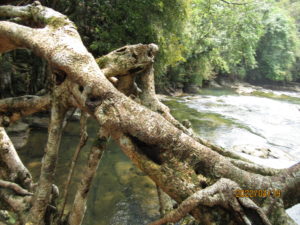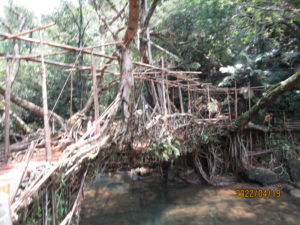By Priyan R Naik
 My trip to Meghalaya would be incomplete without catching a glimpse of the ‘living roots bridges’. The heavy Sohra rainfall that makes life difficult for the inhabitants has compelled local communities to master the technique of growing living root bridges from tangled roots by evolving an ingenious way of turning an otherwise disastrous situation into an advantage. These root bridges make for a crucial passageway for the rural community located on either side of a gushing stream of water when one cannot construct proper bridges or roads in the midst of deep ravines, dense jungles and steep slopes.
My trip to Meghalaya would be incomplete without catching a glimpse of the ‘living roots bridges’. The heavy Sohra rainfall that makes life difficult for the inhabitants has compelled local communities to master the technique of growing living root bridges from tangled roots by evolving an ingenious way of turning an otherwise disastrous situation into an advantage. These root bridges make for a crucial passageway for the rural community located on either side of a gushing stream of water when one cannot construct proper bridges or roads in the midst of deep ravines, dense jungles and steep slopes.
 Raring to see a living bridge for myself, I travelled to a popular bridge at Riwai village enroute Mawlynnong. Many others seemed to be having similar thoughts as there were umpteen vehicles and a constant stream of people walking through the village, climbing up and down the steps leading up to the bridge. The village inhabitants did not seem to mind this intrusion into their lives and watched us as we reached a fast-flowing stream that had to be crossed using a structural engineering marvel, all made out of the living roots of a tree. I saw two or three rubber fig trees with their trunks bent and roots fused together on
Raring to see a living bridge for myself, I travelled to a popular bridge at Riwai village enroute Mawlynnong. Many others seemed to be having similar thoughts as there were umpteen vehicles and a constant stream of people walking through the village, climbing up and down the steps leading up to the bridge. The village inhabitants did not seem to mind this intrusion into their lives and watched us as we reached a fast-flowing stream that had to be crossed using a structural engineering marvel, all made out of the living roots of a tree. I saw two or three rubber fig trees with their trunks bent and roots fused together on  either bank. Bent trunks that are covered with moss and formed an arching canopy, while the sides of the bridge have roots weaved, intricately; and the floor of the bridge is laden with pebbles and mud that forms a cushion for easy walking.
either bank. Bent trunks that are covered with moss and formed an arching canopy, while the sides of the bridge have roots weaved, intricately; and the floor of the bridge is laden with pebbles and mud that forms a cushion for easy walking.
The concept and architecture is indeed fascinating. Starting off, when a rubber fig tree establishes dominance over the host plant it germinates on, only to smother it with its roots and huge spreading canopy, with its aerial roots providing support to the massive canopy while its branches and roots self-graft, it grows into a single structure with the passage of time. Native community  members intertwine the roots propelling them towards the opposite bank allowing them to thicken and produce secondary roots which are woven back into the structure. Other techniques, bequeathed from one generation to another teach how roots should be twisted, tied and pulled to merge with the existing structure. These interwoven roots are strong enough to support use by as many as 20 people at a time. The roots entwined with rubber and bamboo trees take 10 to 15 years to grow before becoming strong
members intertwine the roots propelling them towards the opposite bank allowing them to thicken and produce secondary roots which are woven back into the structure. Other techniques, bequeathed from one generation to another teach how roots should be twisted, tied and pulled to merge with the existing structure. These interwoven roots are strong enough to support use by as many as 20 people at a time. The roots entwined with rubber and bamboo trees take 10 to 15 years to grow before becoming strong  suspension bridges capable of lasting for centuries, these bridges are unfortunately becoming victims of their own popularity, a potential problem area being the heavy tourist footfall which is bound to adversely affect the longevity of these bridges.
suspension bridges capable of lasting for centuries, these bridges are unfortunately becoming victims of their own popularity, a potential problem area being the heavy tourist footfall which is bound to adversely affect the longevity of these bridges.
These bridges are not just sustainable, but have low maintenance costs. They are grown by the local community purely with locally available resources. The trees meanwhile sustain native fruit-eating birds, act as a habitat for squirrels, support pollinating insects, promote growth of moss,  effectively moulding the eco-diversity. Clouded leopards and bark deer are also known to navigate through these bridges at night. Even as I was fascinated by Riwai’s single decker root bridge, I heard about a famed double decker root bridge close to Mawlynnong, visiting which requires a high fitness level necessary for a 3 to 4 hour trek over assorted bridges, clean rivers and picturesque hills that require 5000 odd steps up and down.
effectively moulding the eco-diversity. Clouded leopards and bark deer are also known to navigate through these bridges at night. Even as I was fascinated by Riwai’s single decker root bridge, I heard about a famed double decker root bridge close to Mawlynnong, visiting which requires a high fitness level necessary for a 3 to 4 hour trek over assorted bridges, clean rivers and picturesque hills that require 5000 odd steps up and down.
India is celebrating the construction of the world’s highest rail bridge on the Chenab, a steel and concrete arch bridge in the Reasi district of Jammu and Kashmir, completed and inaugurated in August 2022. Alongside this singular achievement, we must give due recognition to the 100 odd living root bridges of Meghalaya that stand testimony to a natural heritage and human ingenuity, bridges that leave a carbon-negative footprint, that are alive and continuously growing.
The author is a Bengaluru based contributor at The Shillong Times .



